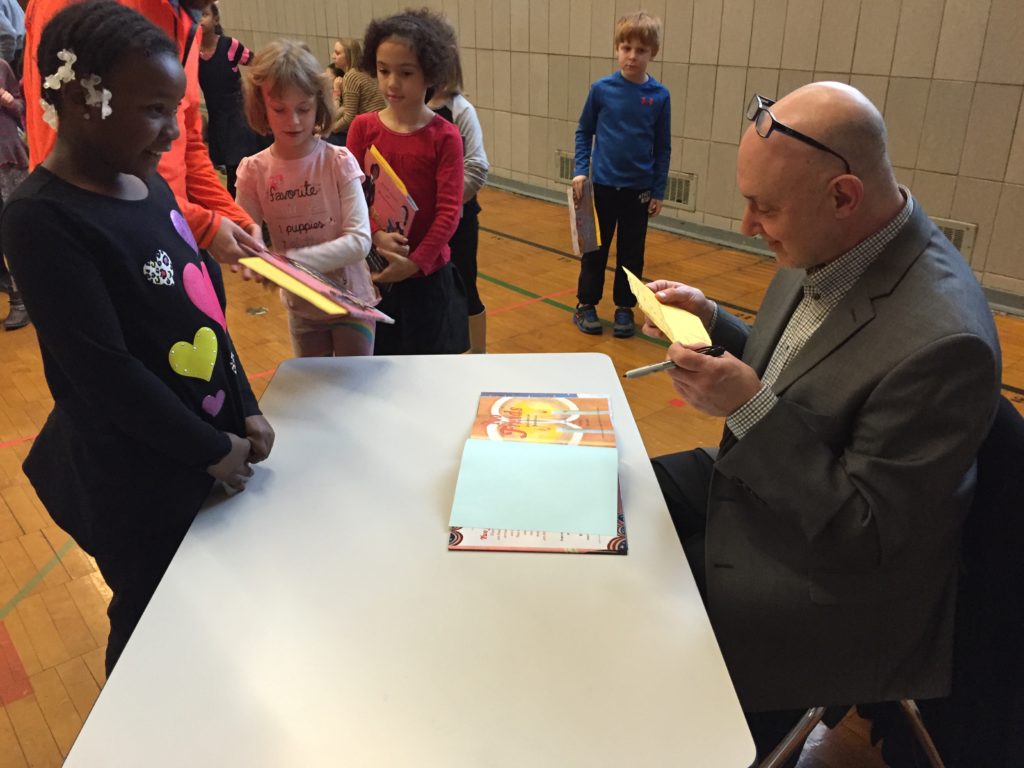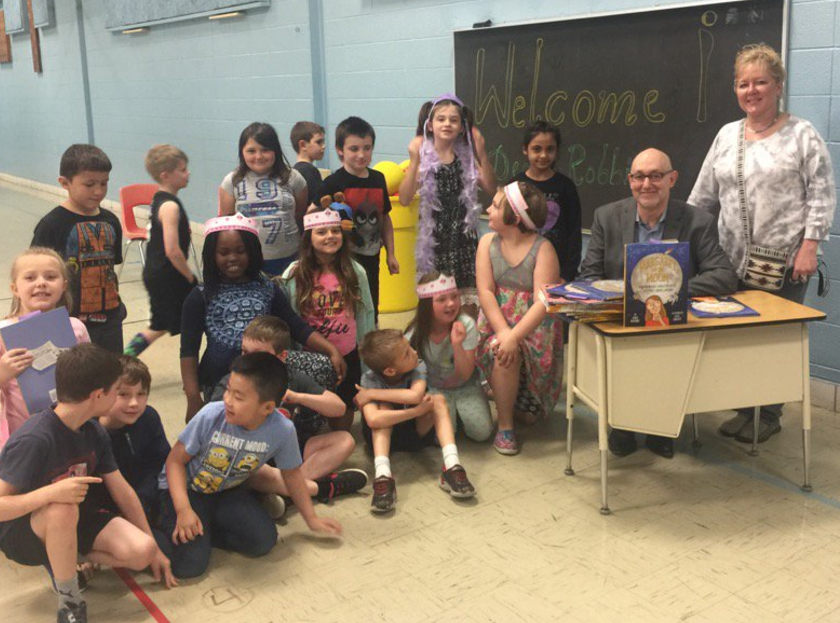Drawing on my experience as a K-12 teacher, children’s author, and journalist, I love visiting schools with my presentations for kindergarten through fifth grade. I explore what it means to be a hero while teaching students about Susan B. Anthony, Frederick Douglass, Alice Paul, Margaret Hamilton, Alan Bean, and other brave historical figures from my nonfiction picture books. My talk also delves into the secrets of being a writer and putting together a book.
A single presentation can run anywhere from 15 to 45 minutes, for any combination of grades. I can also visit for a half or full day of activities. I typically appear in a school auditorium or library, using PowerPoint slides, props, call-and-response, and other interactive elements to engage the students. Though my primary audience is K-5, I also give talks for older students.
Please email dean@deanrobbins.net if you’d like to discuss booking me for a school visit or a speech. You can also book a school visit through Scholastic for a half-day, whole day, or multiple days, including large-group presentations and talks for individual classes.
Elementary school teachers often assign classroom activities before or after one of my presentations. See below for examples of curriculum ideas and activities tied to my children’s picture books You Are a Star, Martin Luther King, Jr. (Scholastic); The Fastest Drummer: Clap Your Hands for Viola Smith! (Candlewick); You Are a Star, Malala Yousafzai (Scholastic); You Are a Star, Jane Goodall (Scholastic), You Are a Star, Ruth Bader Ginsburg (Scholastic); The Shape of Things: How Mapmakers Picture Our World (Knopf); Mambo Mucho Mambo!: The Dance That Crossed Color Lines (Candlewick); The Fastest Girl on Earth!: Meet Kitty O’Neil, Daredevil Driver! (Knopf); Thank You, Dr. Salk: The Scientist Who Beat Polio and Healed the World (Farrar Straus and Giroux); The Astronaut Who Painted the Moon: The True Story of Alan Bean (Scholastic), Two Friends: Susan B. Anthony and Frederick Douglass (Scholastic), Miss Paul and the President: The Creative Campaign for Women’s Right to Vote (Knopf), and Margaret and the Moon: How Margaret Hamilton Saved the First Lunar Landing (Knopf).
Your presentation was spot-on for our classes. Thank you for developing such a brilliant way to reach these children! I was so impressed by their questions and responses (yours and theirs). It was exciting to watch their brains ticking away as they processed this information. I loved the way they identified qualities that make a hero…you have planted a seed that is already growing. I also want to thank you for the attention you paid to each student as you signed their book. That was more than the icing on the cake–that was an integral part of the experience for them.
—University of Wisconsin-Madison Odyssey Project
Thank you for such a wonderful presentation. The feedback from staff and students has been great. Everyone loved how engaging and interactive the presentation was. Your books have given us a way to approach difficult topics in a way that is engaging and appropriate for our students. Parents were thrilled to see their children so excited about books and especially about learning lessons from your books.
—Milwaukee Spanish Immersion School
Dean Robbins made a memorable connection for students between historical heroes and how kids could be heroes in their own lives. Our students were engaged in the history and the beauty of his book. It was a great presentation!
—Madison Elementary School
You introduce today’s children to people who’ve made a fantastic impact on the world. You’ve brought the past to life in a way that inspires them to learn more!
–Cooper Elementary School
We all loved your presentation, with its great messages! I heard so much positive feedback from so many students and staff members. Thank you for this learning event and for being so inspirational to all!
–MacDowell Montessori School
Thank you for visiting our kindergarten through third-grade classes virtually. We enjoyed learning about your books as well as what inspired you to become an author. Your presentation was interesting and engaging!
–South Maple Elementary School
Your presentations were so engaging, and the kids really loved them!
–Durham Academy
Thank you so much for coming to the library with your wonderful book presentation. It was thoroughly enjoyed by all, and your books were all checked out by the end of the day!
–Bacchhuber Memorial Library
Activities for You Are a Star, Martin Luther King, Jr.
- In his famous “I Have a Dream” speech, Martin Luther King, Jr., dreamed of people from all backgrounds living together in peace. What is your dream for making the world a better place? Make up a short speech where you explain your dream to other people.
- Martin Luther King, Jr., wanted to solve the problem of discrimination. Read You Are a Star, Martin Luther King, Jr. and make a list of the ways that Black people were discriminated against in his time.
- Martin Luther King, Jr., had many ideas for ending discrimination. Read You Are a Star, Martin Luther King, Jr. and list three of his ideas.
- Martin Luther King, Jr., liked learning interesting words that he could use in his speeches. Find three words you don’t know in a book or on the internet and look up their meanings in the dictionary.
- Martin Luther King, Jr., admired the United States Constitution, which guarantees rights for all Americans. Read You Are a Star, Martin Luther King, Jr. and list three of these rights.
- Martin Luther King, Jr., enjoyed singing songs about making the world a better place, like “We Shall Overcome.” Find “We Shall Overcome” on the internet, learn the words, and try singing it yourself.
- Martin Luther King, Jr. wrote part of his famous “Letter from Birmingham Jail” on the toilet paper he had in his jail cell. Get a pen and a piece of toilet paper and try writing a sentence on it to see how hard that is to do!
- Martin Luther King, Jr., and the others in the civil rights movement made signs to show what they believed in, like “We Want Freedom” and “Equal Opportunity for All.” Try making your own sign with a marker and a piece of paper or cardboard, showing what you believe in.
- Voting for the politicians you agree with is an important part of being an American citizen, and Martin Luther King, Jr., tried to make sure that all African American adults had the right to vote. Learn the names of three politicians in your city or state by looking on the internet or asking an adult.
- At the end of You Are a Star, Martin Luther King, Jr. is a list of “Martin’s Wise Words.” Look in a book or on the internet and find another one of Martin’s powerful sayings.
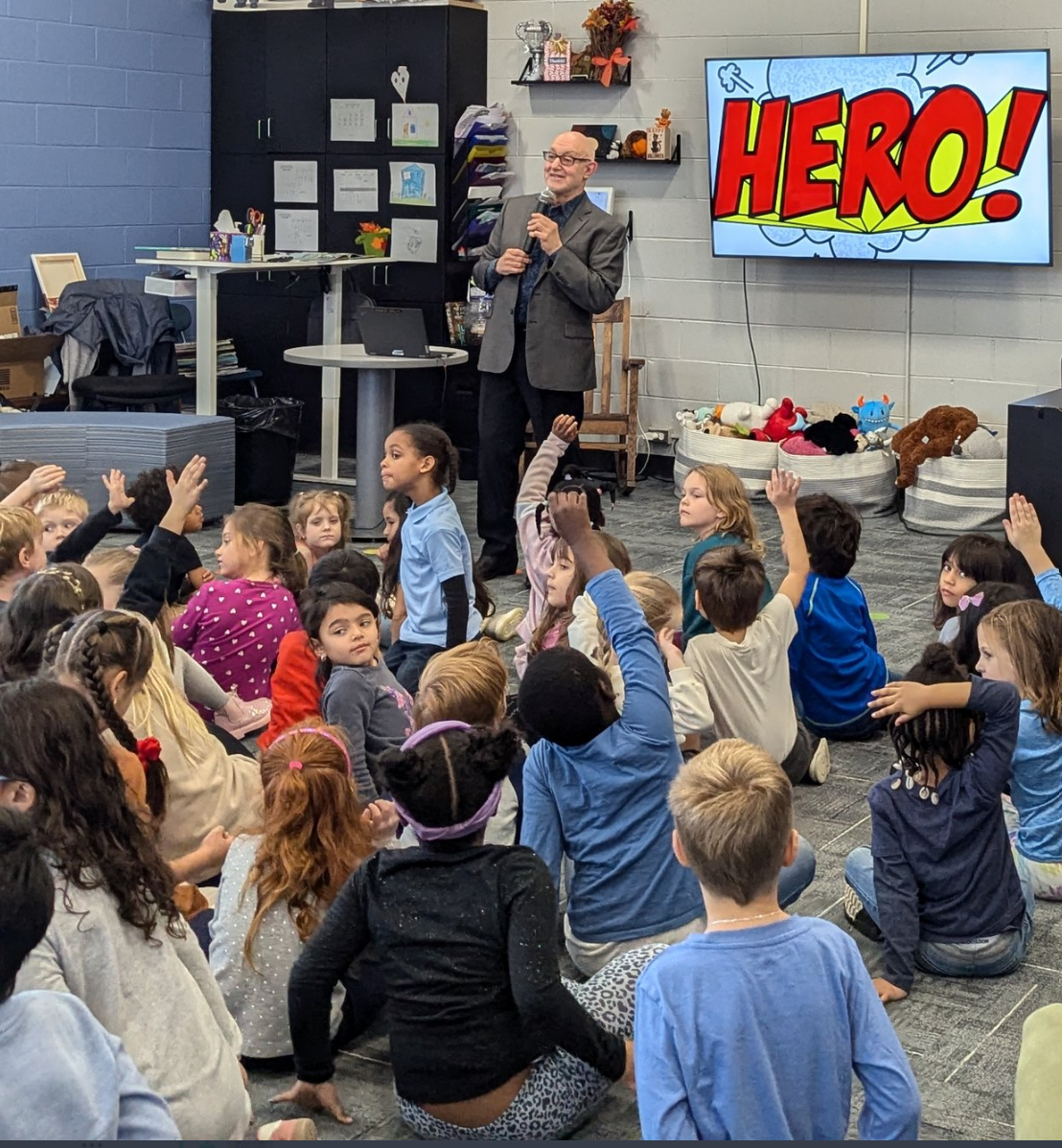 Activities for The Shape of Things: How Mapmakers Picture Our World
Activities for The Shape of Things: How Mapmakers Picture Our World
The Shape of Things: How Mapmakers Picture Our World shows how people from different cultures, over thousands of years, have combined art and science to create their own unique maps. From dots on a cave wall to the latest digital technology, we chisel, paint, draw, and code as a way of measuring the world around us—the world we all share.
- In The Shape of Things, people create maps in different ways: by drawing on a cave wall, sketching in the sand, carving in clay, or using computers. A map shows where things are and how they connect to each other. Make a map of where you are right now by drawing yourself and all the things around you.
- Mapmakers use color to show the different parts of a place. Draw a map of a place you know using at least 10 different colors.
- Look at a map of the world or a globe and find the place where you live.
- Polynesian people created maps with shells and sticks. Create your own map with rocks, sticks, leaves, and any other objects you can find. Use each of the objects to stand for something in the real world.
- Thousands of years ago, people did not have the scientific tools to understand that the Earth is round. Some people thought it was flat, with monsters around the edges! Draw a silly picture of the Earth that might have existed before people knew what it really looks like.
- Mapmakers take measurements to create maps. Measure the walls of a room using a ruler, a tape measure, or your own feet. Draw a map of the room and write in these measurements where they belong.
- The Shape of Things has an illustrated timeline at the end. Make a timeline of your own life and illustrate it.
- Go somewhere you have never been before and draw a map of the place.
- Famous people from American history were mapmakers: George Washington, Benjamin Banneker, Thomas Jefferson, Abraham Lincoln, and Theodore Roosevelt. Pick one or two of these people, read about their lives in a book or on the internet, and write a few sentences about them.
- Look up pictures of the tools that mapmakers use on the internet or in a book: a compass, a Gunter chain, a theodolite, an automatic level, or a magnetic locator. Make a drawing of your favorite tool.
 Activities for The Fastest Drummer: Clap Your Hands for Viola Smith!
Activities for The Fastest Drummer: Clap Your Hands for Viola Smith!
The Fastest Drummer: Clap Your Hands for Viola Smith is about a pioneering female instrumentalist who became famous as “The Fastest Girl Drummer in the World.” Viola boldly championed her fellow women players in the 1930s and ’40s, opening doors in the music industry.
- Viola Smith dreamed of being a great drummer. Name three things she did to make her dream come true.
- Viola Smith played many kinds of drums, including snare drums, bass drums, tom-toms, cymbals, and timpani. Using The Fastest Drummer or another source, draw the drum that looks most interesting to you.
- Viola Smith called her all-women band The Coquettes. Think about a band you might start one day. What name would you give it?
- When Viola Smith started playing the drums, she wasn’t very good. But after practicing, she became one of the best drummers in the world. Think of something you’d like to be good at. What would you need to do to practice?
- Viola Smith played a kind of music called “jazz.” Look up a video of a famous jazz musician on the internet, such as Duke Ellington, Louis Armstrong, or Mary Lou Williams. Name one of their songs you like and explain why.
- Look up the video of Viola Smith and The Coquettes playing “Snake Charmer” on the internet. Listen for Viola’s solos–the parts where she plays by herself. How many solos does she take?
- Viola Smith wanted to play music at a time when most bands would not hire a woman drummer. What is a challenge you have faced in your own life? How did you try to overcome it?
- Viola Smith liked to do things in a fancy way, like bouncing her sticks off a drum and catching them in the air. Draw a picture of yourself doing something in a fancy way.
- Viola Smith helped other women find a place in the music business. What is a way that you have helped someone you know?
- Viola Smith was still playing her drums at the age of 100. What is something you would still like to be doing at 100?
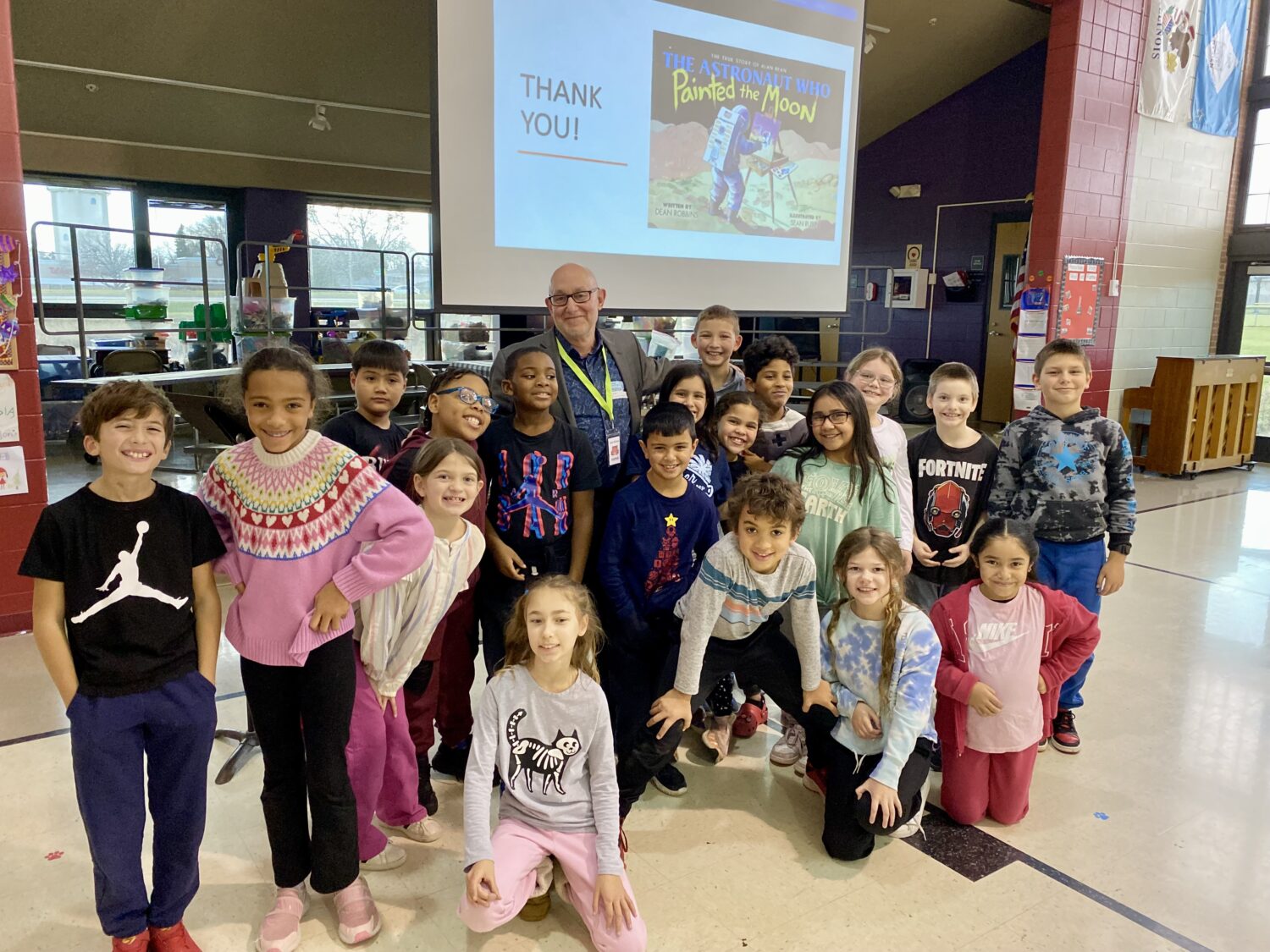 Activities for You Are a Star, Malala Yousafzai
Activities for You Are a Star, Malala Yousafzai
You Are a Star, Malala Yousafzai is about an 11-year-old Pakistani girl who courageously challenges those who deny her right to an education. She becomes the youngest person to receive a Nobel Prize by giving hope to children around the world.
- Malala Yousafzai loved school more than anything. List three things you like about going to school.
- Malala Yousafzai also loved her hometown of Mingora, in the country of Pakistan. List three things you like about the place where you live.
- Malala Yousafzai always smiles, even during hard times. Draw a picture of yourself smiling, and include some of the things that make you smile.
- Malala Yousafzai dedicates herself to helping those in need. Who needs help in your community? Write out a plan for what you could do to help them.
- Malala Yousafzai drew math problems on her hand to show how much she liked math. Draw a picture of your own hand, and draw something on it to show what you like about school.
- Malala Yousafzai loved the color pink. Draw a picture of yourself and the things in your life using your favorite color.
- Malala Yousafzai stood up to those who thought girls should stay at home and not go to school. Using books or a computer, find three girls who grew up to do amazing things.
- Malala Yousafzai showed what she believed in by making speeches. Write a short speech about something you strongly believe. Practice giving at home or in class!
- When Malala Yousafzai had to escape her town of Mingora, she put her favorite books in a bag to protect them from harm. List the three books you would try to save if you were in Malala’s place.
- Malala Yousafzai continued going to school even when the Taliban threatened her. Name something you believe in so strongly that you would defend it under any circumstances.
- Malala Yousafzai started “The Malala Fund” to guarantee every girl an education. If you started a charity and named it after yourself, what would it do and who would it help?
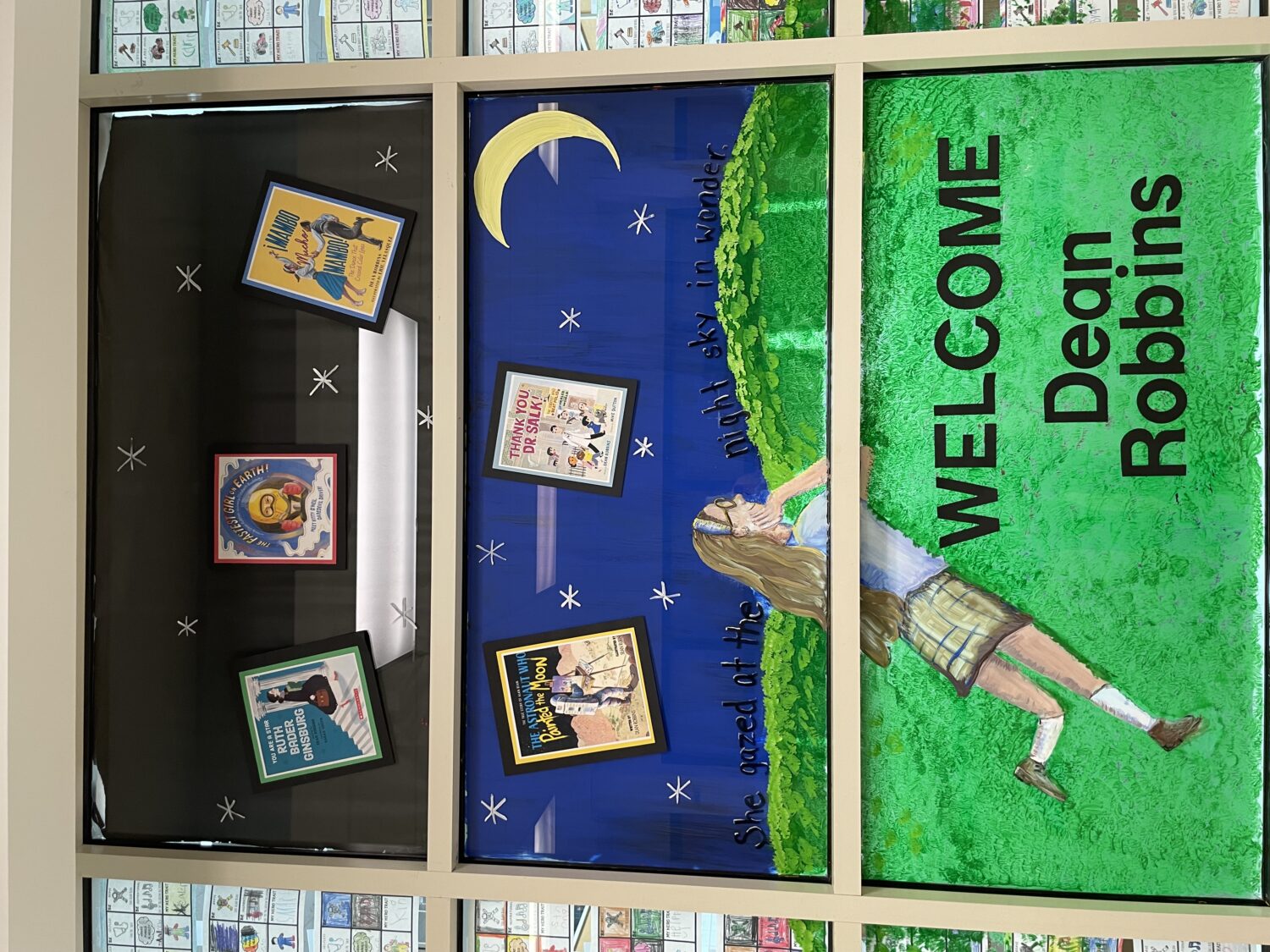 Activities for You Are a Star, Jane Goodall
Activities for You Are a Star, Jane Goodall
You Are a Star, Jane Goodall is about a girl who dreams of growing up to study animals in Africa. She becomes the first scientist to live among chimpanzees in the wild and—with the help of a friendly chimp named David Greybeard—makes a series of world-changing discoveries.
- Jane Goodall discovered that animals have personalities and emotions, like humans. That’s why she gave chimpanzees names rather than calling them by numbers, the way other scientists did. Cut out pictures of animals and give each one a name.
- Jane Goodall dressed a dog in pajamas and pushed him around her neighborhood in a baby carriage. Draw a picture of your favorite animal wearing pajamas.
- Jane Goodall started a club with her friends to study animals, and she named it the Alligator Club. Think of your own name for a club that would explore nature. What would you call it? Make a list of the club’s activities.
- Jane Goodall dreamed of going to Africa to study animals. Where on Earth would you like to go? Read about a country, a continent, a city, or some other place and write about what you would like to study there.
- In the jungle, Jane Goodall had the idea of acting like chimpanzees so they would get used to her and stop running away. Pick an animal, learn how it acts, and imitate the things it does.
- Jane Goodall learned that each chimpanzee is different. Search on the internet for the names of chimpanzees she met in the jungle, including David Greybeard, Flo, Fifi, Figan, Goliath, Golden, and Glitter. Pick one or two of the chimps, read about them, and describe what they are like.
- Jane Goodall discovered that chimpanzees make and use tools. Make a list of tools that humans use, and describe what each one does.
- Jane started the Jane Goodall Institute to make the world a better place. Read about the institute on the internet and list what it does to help people, animals, and the Earth.
- Jane Goodall started a group called Roots & Shoots to help young people solve problems where they live. What problems do you see in your city, school, or neighborhood? Make a list of the ways you could help solve them.
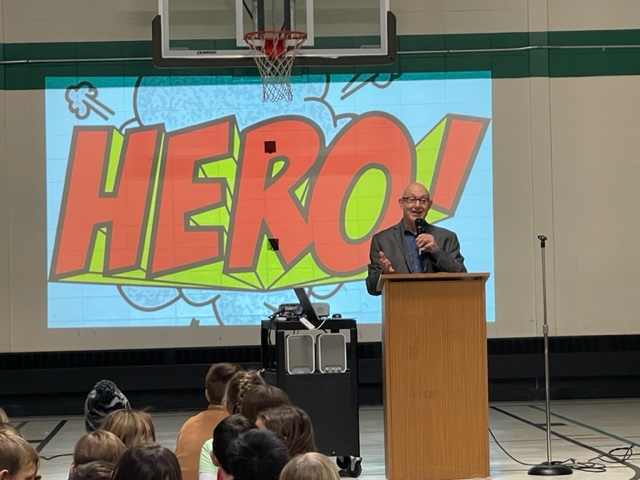 Activities for You Are a Star, Ruth Bader Ginsburg
Activities for You Are a Star, Ruth Bader Ginsburg
You Are a Star, Ruth Bader Ginsburg is about a quiet girl who dreams of doing something great in her life. Ruth breaks through barriers for women to become a lawyer who fights for equality and justice, and her skill and determination take her all the way to the Supreme Court. She sticks up for ordinary people to make the world a better place.
- Being treated differently because of who you are is called “discrimination.” As a girl, Ruth Bader Ginsburg faced discrimination for being female, lefthanded, and Jewish. But she was proud of who she was, and she vowed to succeed in spite of discrimination. Draw a picture of yourself and list everything about you that you’re proud of.
- Young Ruth Bader Ginsburg drew courage from the heroes she read about in the library, like pilots, detectives, and goddesses. Who are your heroes? Draw a picture of one of them.
- Ruth Bader Ginsburg was good at some things, like writing, making speeches, and playing the cello. She wasn’t so good at other things, like singing, cooking, and handwriting, but she had a sense of humor about it. List three of the things you are good at, and one thing you’d like to be better at with hard work.
- Ruth Bader Ginsburg wanted to do something great when she grew up, but she wasn’t sure what. Think of something you might want to be as an adult and draw a picture of yourself doing that job.
- The United States Constitution is our most important set of laws. It lists all our freedoms, which are also known as rights. Using books or the internet, find one of the rights that the Constitution guarantees. Why is it important to have that right?
- Ruth Bader Ginsburg’s mother taught her to show respect for people she disagreed with. That way, Ruth could have polite discussions with everyone. Sometimes she changed their minds, and sometimes they changed hers. Write about a time when you either a) changed your mind about something, b) changed someone else’s mind about something, or c) wanted to change someone’s mind but weren’t able to. Discuss!
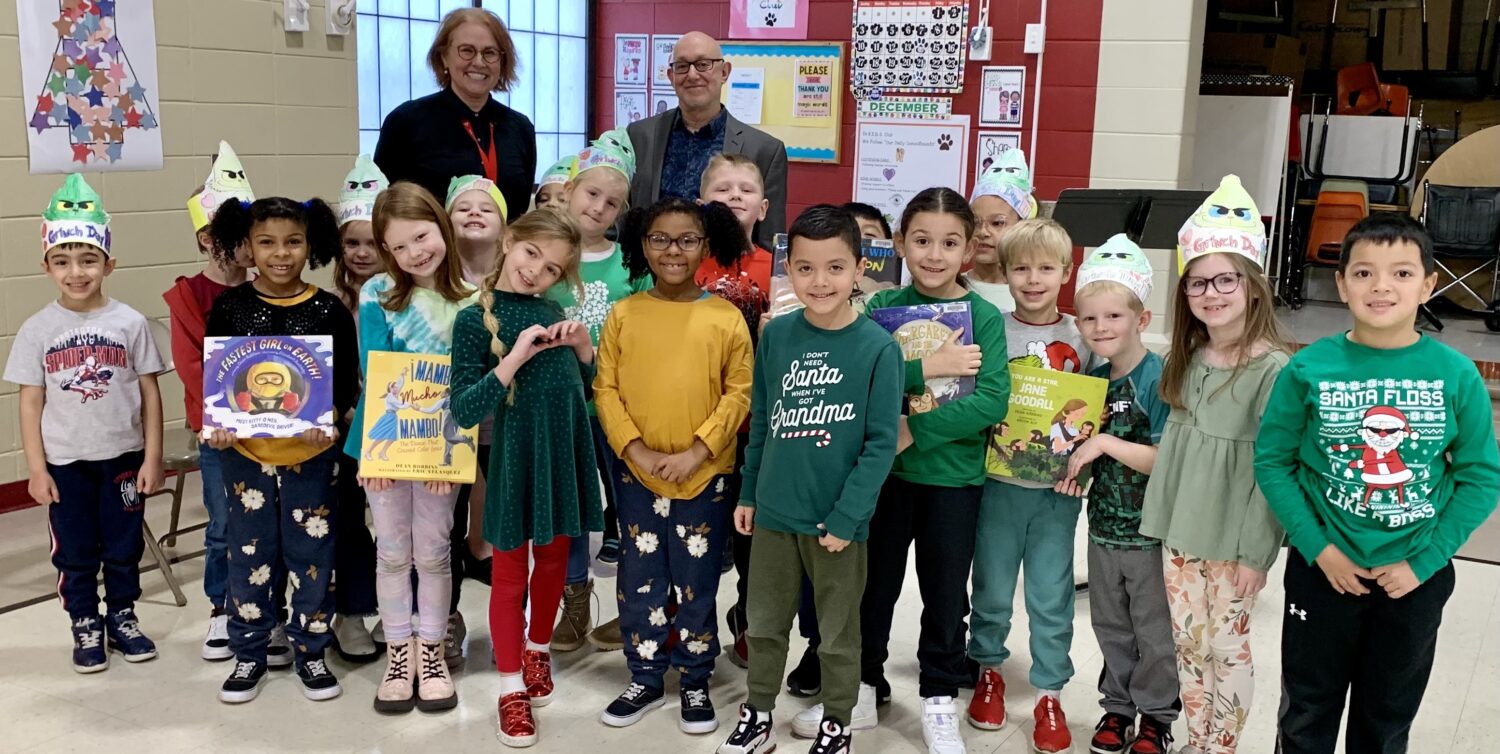
- In college, Ruth Bader Ginsburg fell in love with the law. Using You Are a Star, Ruth Bader Ginsburg as a guide, draw a picture of a lawyer in a courtroom making an argument to a judge.
- In college, Ruth Bader Ginsburg studied in the quietest place she could find—a bathtub! Draw a picture of yourself in your favorite place to study.
- Ruth Bader Ginsburg worked hard in her job at a lawyer, but she also liked to have fun. She danced, went to operas, played sports, and traveled. Draw a picture of yourself doing your favorite hobby.
- Whenever Ruth Bader Ginsburg got too serious, her daughter and husband tried to make her laugh. If she did, they wrote it down in a book called “Mommy Laughed.” Try to make an adult laugh yourself. Keep a notebook of your successes!
- Ruth Bader Ginsburg was the second woman to join the most important court in the United States, the Supreme Court. Using a book or the internet, find the name of a Supreme Court justice from the 1700s to today. Write down two interesting facts about that person.
- To help women succeed in the workplace, Ruth Bader Ginsburg let her staff take care of their children on the job. That meant her law office was full of kids, baby bottles, and toys. Draw a picture of this wild scene, using You Are a Star, Ruth Bader Ginsburg as a guide.
- The Supreme Court’s black robes were designed for men to wear with neckties. But when Ruth Bader Ginsburg joined the court, she added her own touch: fancy collars that she wore for special occasions. Draw yourself as a Supreme Court justice in a black robe and add your own touch, whether it’s a hat, a pair of shoes, a necklace, or an interesting design.
- When Ruth Bader Ginsburg became famous, people put her initials “RBG” on t-shirts, coffee mugs, posters, and even their fingernails. What would you like to see your initials on if you were famous? Draw picture of it!
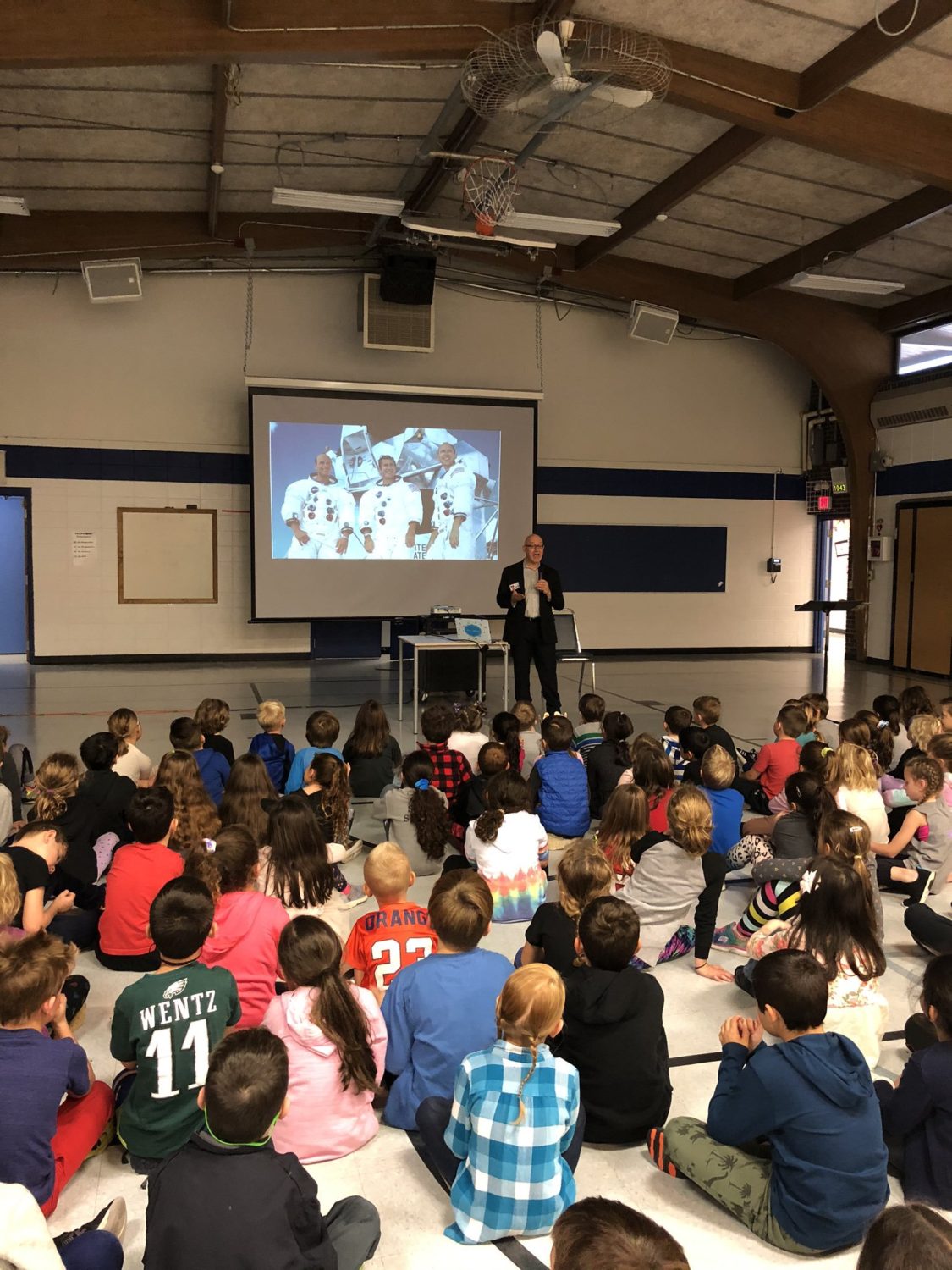 Activities for Mambo Mucho Mambo! The Dance That Crossed Color Lines
Activities for Mambo Mucho Mambo! The Dance That Crossed Color Lines
Mambo Mucho Mambo! is a nonfiction children’s picture book set in segregated New York City in the 1940s, when people from different backgrounds weren’t allowed to dance in the same places. But one day, the Palladium Ballroom opens its doors so everyone can enjoy a thrilling new sound called Latin jazz and a bold new dance called the mambo. When Millie Donay and Pedro Aguilar meet on the Palladium’s dance floor, their cross-cultural partnership anticipates the civil rights movement that will tear down barriers throughout the United States.
See here for the Candlewick Press teachers’ guide, and here for TeachingBooks’ Virtual Author Tour for Mambo Mucho Mambo!
- Mambo Mucho Mambo! is about people from all backgrounds gathering in a place where they can enjoy a brand-new creative activity. In the book, the activity is the mambo, a new dance for a new kind of music called Latin jazz. Use your imagination to think up your own brand-new creative activity. It could be a new sport, a new game, a new dance, a new business, a new food, a new kind of art, a new type of music, or something else. Think of an interesting name for your activity, the way people made up the name “mambo” for their new dance. For example, you could create a game called “Glass Pass” where you try to throw a penny into a glass. Or a dance called “The Kangaroo Hop” where you jump around the room. Or a kind of art called “Toaster Portraits” where you cut out a face from a piece of toast. Or a type of storytelling called “Puppy Tales” where all the characters are dogs. Either draw a picture that shows your activity or describe it with words. Then do the activity yourself and teach someone else how to do it, too. Have fun and let your imagination run free!
- Mambo Mucho Mambo! takes place in the 1940s, when much of the United States was segregated. Look up the word “segregation” in the dictionary or on the internet, or ask an adult what it means. Discuss some of the ways segregation might have been harmful to people back then.
- When the Palladium Ballroom opens its doors to people of all backgrounds in Mambo Mucho Mambo!, it marks the start of integration in the United States. Look up the word “integration” in the dictionary or on the internet, or ask an adult what it means. Discuss some of the ways integration might have been helpful to people back then.
- Mambo Mucho Mambo! shows people from all backgrounds dancing together at the Palladium Ballroom. Draw your own picture of diverse people having fun together at a dance.
- Mambo Mucho Mambo! is about an exciting kind of music called Latin jazz, which used trumpets, saxophones, maracas, congas, and other instruments. Using the book as a guide, draw a picture of a band playing Latin jazz.
- Mambo Mucho Mambo! is also about an exciting kind of dance called the mambo, in which people move forward and backward and side to side. Using the book as a guide, draw a picture of two people dancing the mambo together.
- Search the internet for a video of people dancing the mambo. You can look for ideas in the “Resources” section at the end of Mambo Mucho Mambo! After you’ve watched a video, try dancing the mambo yourself! You can also try it with a partner.
- There have been many kinds of dances with interesting names, like the Jitterbug, the Bunny Hop, and the Twist. Do some research and make a list of your favorite dance names. Then make up your own dance with its own creative name.
- By challenging segregation, the Palladium Ballroom paved the way for the 1950s civil rights movement. Learn about this movement from a dictionary or the internet, or by talking to an adult. Make a list of the ways it changed the United States for the better.
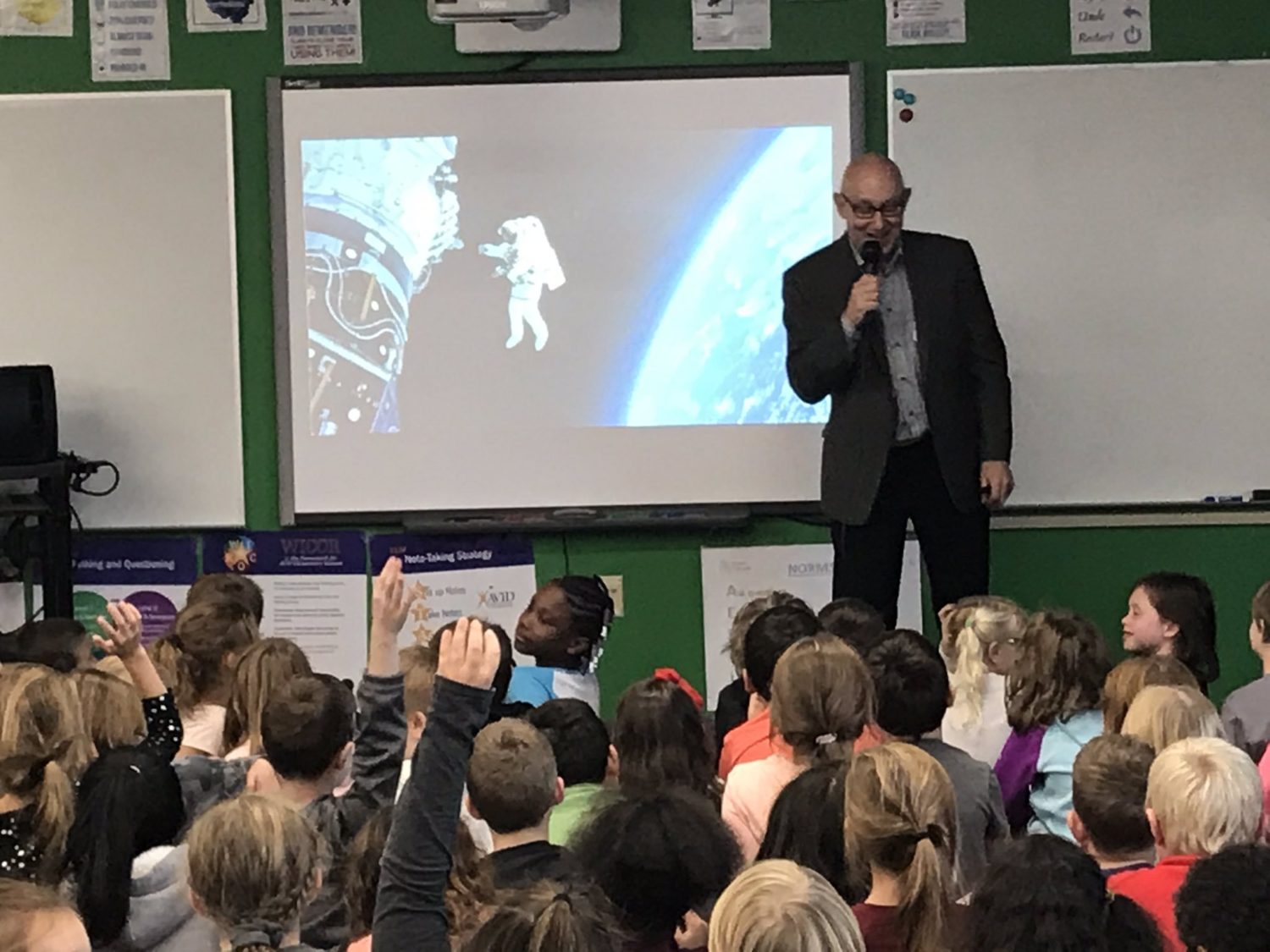 Activities for The Fastest Girl on Earth! Meet Kitty O’Neil, Daredevil Driver!
Activities for The Fastest Girl on Earth! Meet Kitty O’Neil, Daredevil Driver!
The Fastest Girl on Earth! is a nonfiction children’s picture book about one of the bravest women in American history. Kitty O’Neil sets world records in water-skiing, boat racing, and driving, most notably the women’s land-speed record in a rocket-powered car. Amazingly, Kitty accomplishes these feats after losing her hearing as a child. Today’s children can find a role model in this woman who overcame a disability to set a record that stood for more than 40 years.
- Kitty O’Neil’s rocket-powered car was called the Motivator. Draw a picture of your own super-fast car and give it a cool name.
- Because Kitty O’Neil was deaf, she asked an assistant to do a countdown in sign language before her record-breaking run in the Motivator. Look at the drawings that show the numbers 1 through 10 in sign language in The Fastest Girl on Earth, then learn them yourself from a book or the internet. Do a sign-language countdown from 10 to 1.
- Kitty O’Neil is only one of many disabled people who have done amazing things. Franklin Roosevelt, who lost the use of his legs, became president of the United States. Marla Runyan, who lost her sight, became a champion runner. Use books or the internet to list five other disabled people who have overcome disabilities to make a mark in the world.
- Kitty O’Neil once said “I’m not afraid of anything!” Draw a picture of something you’re afraid of. Put yourself in the picture, bravely overcoming your fear.
- Kitty O’Neil was good at many sports: driving, waterskiing, boating, hang gliding, ice skating, jet flying, horse riding, karate, and motorcycle racing. What are you best at doing, whether in sports or something else? Draw a picture of yourself that shows your greatest talent.
- Kitty O’Neil loved going faster than anyone ever had before. Use a book or the internet to list five speed records people have set by running, skating, flying, swimming, jumping, driving, sailing, etc.
- Kitty O’Neil set records as the fastest water skier, the fastest boat racer, and the fastest driver. Look at the pictures of Kitty setting her records in The Fastest Girl on Earth and draw one of them yourself.
 Activities for Thank You, Dr. Salk!: The Scientist Who Beat Polio and Healed the World
Activities for Thank You, Dr. Salk!: The Scientist Who Beat Polio and Healed the World
Thank You, Dr. Salk! is a nonfiction children’s picture book about quiet boy who dreams of relieving the world’s suffering. Can Jonas Salk find a way to protect people from polio, the terrible disease that strikes millions of children? Jonas grows up to be a doctor and experiments with a polio vaccine. Finally, he makes a breakthrough—and the whole world celebrates by saying “Thank you, Dr. Salk!”
- In 1954, two million elementary school children helped test Jonas Salk’s polio vaccine. After getting their injections, they received a special card and a pin that honored them as Polio Pioneers. Make your own fancy Polio Pioneer card and pin. Cut out the pin and tape it to your shirt.
- In Thank You, Dr. Salk!, illustrator Mike Dutton draws a picture of people wildly celebrating the success of Jonas Salk’s vaccine. Draw your own picture of people celebrating the end of the COVID-19 pandemic, either copying Mike’s drawing or creating one from your own imagination.
- People wrote thank-you notes to Jonas Salk after his vaccine successfully prevented polio. Write your own thank-you note to Jonas or other scientists who’ve created vaccines for protecting you from terrible diseases, including COVID-19. Then decorate your thank-you note with a picture.
- In the 1930s, the president of the United States helped start a group called the March of Dimes. Many people—including children—donated dimes to help Jonas Salk and other scientists create a polio vaccine. Think of a group you could start to solve a problem in our own time. What would you call it? Draw yourself holding a sign with the name of your group, like the children on pages 20 and 21 of Thank You, Dr. Salk!
- Jonas Salk was a shy, quiet child, and he was not good at sports. But he had a hero’s courage, as you can see in the picture on page 9 of Thank You, Dr. Salk! Think about something courageous you will do when you grow up and write it on a piece of paper. Then draw yourself in the same heroic pose as Jonas, with your hands on your hips and a determined look on your face
- On page 16 and 17 of Thank You, Dr. Salk!, Jonas Salk studies hard to be a scientist. Draw a picture of you studying something you love.
- Viruses are tiny germs that can invade your body and make you sick. Scientists like Jonas Salk invent vaccines in their laboratories to help you fight off these germs, including the terrible polio virus. Doctors and nurses give you vaccines through sprays, liquids, or shots. The shot might pinch for a second, but the vaccine protects you throughout your life. Draw a picture of yourself bravely getting a shot.
- As a boy, Jonas Salk wanted to make the world a better place, so he decided to become a scientist who prevents disease. List some of the ways you might make the world a better place when you grow up.
 Activities for The Astronaut Who Painted the Moon: The True Story of Alan Bean
Activities for The Astronaut Who Painted the Moon: The True Story of Alan Bean
The Astronaut Who Painted the Moon is a nonfiction children’s picture book about the only artist to travel in outer space. Alan Bean is a unique figure in the history of space exploration: not only a brave astronaut, but also a talented painter. After the pioneering Apollo 12 mission, he pursues his dream of painting the magic and mystery of his trip to the moon. My presentation is geared toward grades pre-K through 5, showing how an airplane-obsessed boy became a daring pilot, then one of the first astronauts in the United States space program, and finally a painter with a unique vision. Using multimedia and audience interaction, I explore both art and science and encourage children to nurture their own creativity. I also describe the thrilling experience of interviewing Bean for The Astronaut Who Painted the Moon.
- An artist is someone who notices interesting things. What does Alan Bean notice when he begins flying airplanes? What does he notice on his trip to the moon?
- As a boy, Alan Bean dreams of being a pilot. What does he do to make that dream come true?
- What do you dream of doing when you grow up? What will you do to make that dream come true?
- In some ways Alan Bean was the same as other astronauts and pilots, and in other ways he was different. Describe the ways he was the same, and describe the ways he was different.
- In what ways are you the same as other kids your age? In what ways are you different?
- As Alan Bean grew up, he dreamed of being an artist. What does he do to make that dream come true?
- When Alan Bean makes paintings of flowers or outer space, they don’t look exactly real, and he doesn’t want them to. Why doesn’t Alan care if his pictures look exactly like the things he’s painting?
- What does it mean when artists “use their imagination”? Explain how they can use their imagination to show how something makes them feel.
- Draw a picture of something that shows how you feel about that thing. Maybe it’s a picture of a friend who makes you feel happy, or a picture of a time when you felt sad. How did you express your feelings in your drawing?
- What real colors does Alan Bean see on the moon? Draw your own picture of the moon using those colors.
- Make a list of how being on the moon is different from being on Earth. Make a list of the emotions you might feel if you were on the moon yourself.
- Sean Rubin, the artist who drew the pictures for The Astronaut Who Painted the Moon, used lots of colors, and he had a reason for each one he chose. Look for one of the colors Sean used on one of the pages and explain why you think he picked it.
- Pick a color and use it for part of your own drawing. Why did you choose that color? Why is it the right color for that part of the drawing?
- Why does Alan Bean decide to start making paintings of the moon? What can the paintings show that a photograph can’t?
- Alan Bean was trained as a scientist. How does he use his scientific training to make his paintings?
- Alan Bean was also trained as an artist. How does he use his artistic training to make his paintings?
- When Alan Bean paints the moon, he uses colors that aren’t really found in outer space. What are those colors? Why does he use them?
- Draw your own picture of the moon using the colors Alan used in his paintings.
- Make your own drawing of something using the real colors of that thing. Now make another drawing of the same thing using colors that aren’t real. Which drawing do you like better?
- Alan Bean makes paintings of outer space to show others how it felt to be up there. Make a drawing of something from your own life to show others how you feel about it. Now show it to people and ask them to guess how you feel about the subject of your drawing.
- How does Alan Bean add real pieces of outer space to his paintings? Why does he do that?
- Make your own drawing of something in nature, then add real things from nature to the drawing. For example, paste on sticks or stamp the paper with rocks.
- At the end of The Astronaut Who Painted the Moon, Alan Bean’s paintings make children dream of being astronauts, artists, or both. Make your own drawing of something you love to do that might make others dream of doing it too.
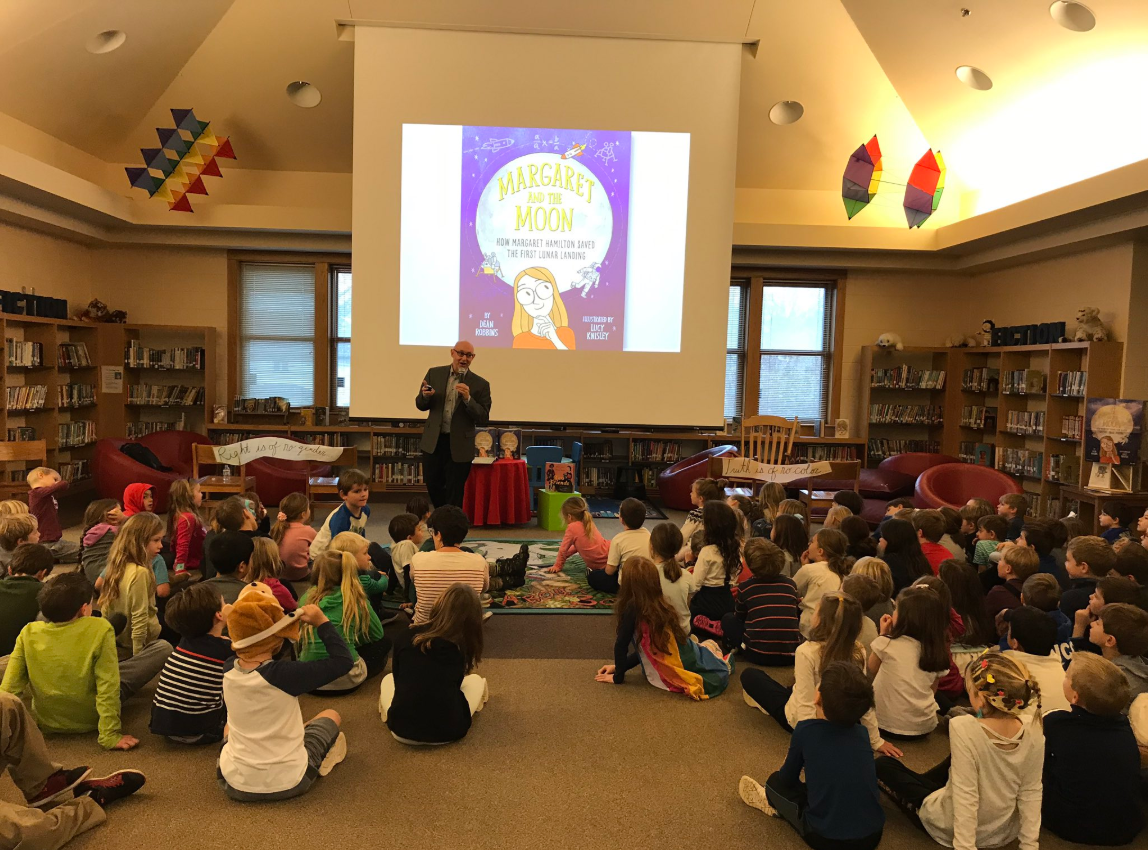
Activities for Two Friends: Susan B. Anthony and Frederick Douglass
Two Friends explores the close friendship of Susan B. Anthony and Frederick Douglass, who meet in Susan’s parlor to sip tea and support one another. This presentation explains how the two activists worked together to secure rights for women and African Americans, showing the value of collaborating to get things done.
See here for Scholastic’s extensive teaching guide for Two Friends, including pre- and post-reading activities, reproducibles, and tie-ins to Common Core standards. Below are some additional ideas for classroom activities.
- In Two Friends, Susan B. Anthony and Frederick Douglass do not have the same rights as other people. Make a list of rights Susan and Frederick want for themselves. Then list the things they do to get those rights.
- In Two Friends, Susan B. Anthony and Frederick Douglass face problems that keep the world from being a better place. List those problems. Then list the problems that keep your neighborhood, your school, or your home from being a better place. How would you solve those problems, the way Susan B. Anthony and Frederick Douglass solved theirs?
- In Two Friends, Susan B. Anthony and Frederick Douglass work hard to get rights for women and African Americans. List Susan and Frederick’s special qualities—the ones that allowed them to win their battles.
- In Two Friends, artists Sean Qualls and Selina Alko have put words in almost every picture: in people’s clothes, in the roads, in butterfly wings, in the snow, on tree bark, and even in the steam coming out of a cup of tea. They did this to show how important words were to Susan B. Anthony and Frederick Douglass, who never stopped reading, writing and talking about freedom. Look through the book and list all the unusual places where words show up in the pictures.
- In Two Friends, Susan B. Anthony and Frederick Douglass learn about rights by reading. What might they have read? Teachers can explain about the Constitution, the Declaration of Independence, and speeches by Abraham Lincoln, Elizabeth Cady Stanton, and others.
- In Two Friends, two real-life heroes team up to make the world a better place. If you could team up with a real-life person, who would it be? List the problems you would solve.
- In Two Friends, two real-life heroes team up to make the world a better place. Think of two of your favorite real-life heroes who could have teamed up—even heroes who might not have lived in the same place or at the same time. List the problems they would solve. Draw a picture of them having tea together.
- Draw a picture of yourself having tea with one of your favorite heroes, the way Susan B. Anthony and Frederick Douglass do in Two Friends. List the things you and your hero would talk about at your tea party.
- Interview a man or a woman you admire, like your mother, father, grandmother, grandfather, or teacher. Ask about their biggest accomplishment or how they have tried to change the world.
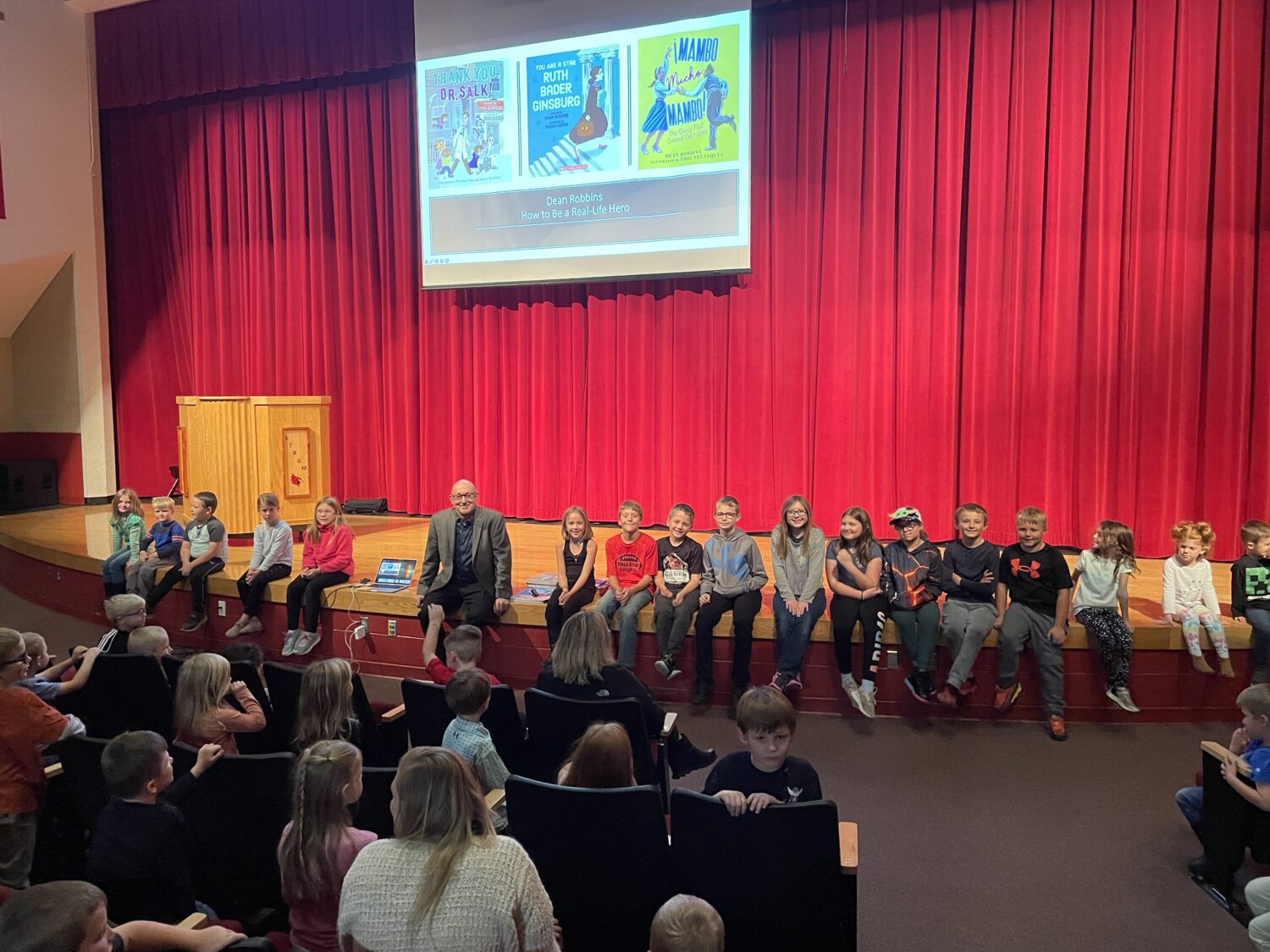 Activities for Margaret and the Moon: How Margaret Hamilton Saved the First Lunar Landing
Activities for Margaret and the Moon: How Margaret Hamilton Saved the First Lunar Landing
In Margaret and the Moon, young Margaret Hamilton turns her love of math and science into a career as a pioneering computer programmer with the United States space program. This presentation explains how Margaret used problem-solving skills to send astronauts to the moon for the first time–and how kids can follow in her footsteps.
See here and here for Knopf’s classroom activities for Margaret and the Moon. Below are some additional ideas.
- Margaret and the Moon has a beautiful picture of Margaret Hamilton looking at the night sky. Draw your own beautiful picture of the night sky with stars, planets, and the moon.
- On the Apollo 11 mission, the spacecraft that landed on the moon was called the Eagle. Draw your own spaceship and give it an interesting name.
- Spaceships don’t have a lot of room, so astronauts can only bring along the things they really need. Make a list of what you’d pack on a trip to the moon, including only the things you really need.
- In Margaret and the Moon, Margaret Hamilton decides to study hard in every subject at school so she can grow up to be anything she wants. What is your favorite subject in school? List the kinds of jobs it might lead to when you grow up.
- In Margaret and the Moon, Margaret Hamilton measures how far it is to the moon, how fast the moon moves, and how big around it is. Pick your favorite planet or star and try to find out how far away it is from Earth, how fast it moves, and how big around it is.
- Margaret and the Moon has a picture of astronaut Neil Armstrong taking the first step on the moon. Draw a picture of yourself walking on the moon in a spacesuit.
- In Margaret and the Moon, Margaret Hamilton wants to use her computer to help get astronauts to the moon for the first time. She tries to think of everything that might go wrong during the trip, and then programs her computer to prevent those problems from happening. Think of a big thing you might want to accomplish, like sailing around the world or climbing a mountain. Make a list of what might go wrong, and another list of how you could prevent those problems from happening.
- In Margaret and the Moon, Margaret Hamilton makes computers do amazing things they’d never done before, like predicting the weather or tracking airplanes through the clouds. List some of the amazing things you’d like to program a computer to do.
- In Margaret and the Moon, Margaret Hamilton is one of the first computer scientists, and she works on some of the first computers. They look very different from today’s computers. Draw either a picture of one of the old computers in the book or one of today’s computers. What are some of the differences?
- In Margaret and the Moon, Margaret Hamilton helps Apollo 8 orbit the moon ten times. She helps Apollo 9 connect two ships in space. She helps Apollo 10 get within ten miles of the moon’s surface. And she helps Apollo 11 land on the moon. Look up the other Apollo space missions and list some of the important things they did.
- In Margaret and the Moon, Margaret Hamilton worked on one of the hardest problems humans ever tried to solve—flying people to the moon. Make a list of other hard problems humans have had to solve, like building the first airplane or inventing the telephone.
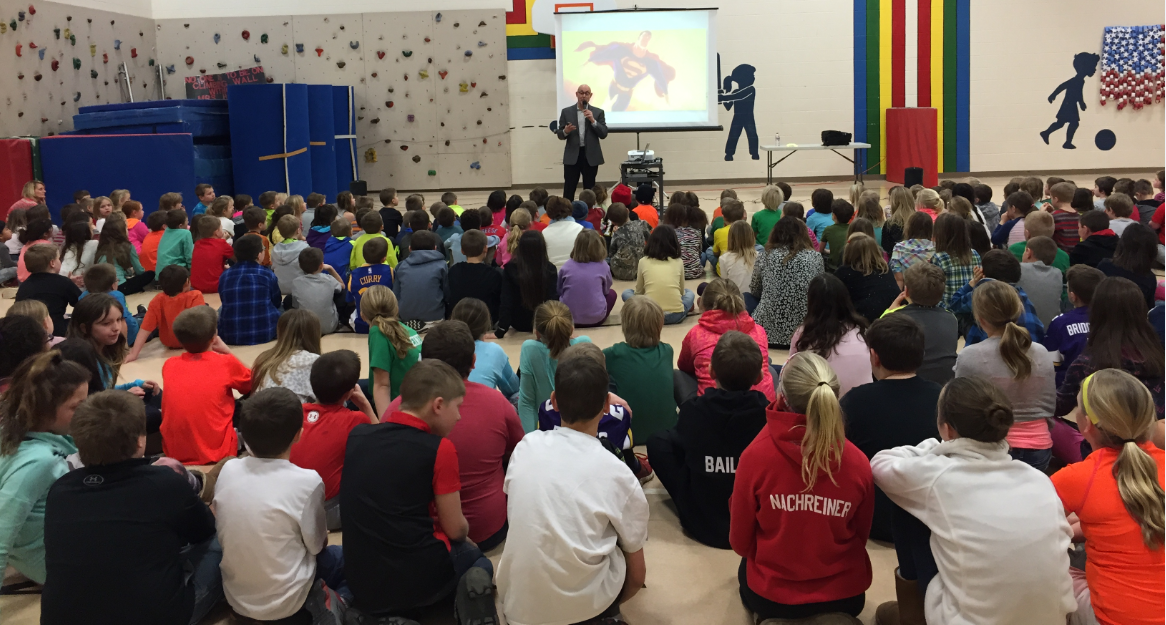 Activities for Miss Paul and the President: The Creative Campaign for Women’s Right to Vote
Activities for Miss Paul and the President: The Creative Campaign for Women’s Right to Vote
In Miss Paul and the President, Alice Paul dreams up creative ideas for convincing President Woodrow Wilson to support voting rights for women, including a fancy parade and a demonstration at the White House gate. This presentation introduces the brave activist and her cause while delving into the wonders of the creative process, whether for solving a problem or expressing yourself.
- In Miss Paul and the President, Alice Paul has lots of creative ideas for convincing President Woodrow Wilson that women should have the right to vote. Make a list of her ideas.
- Make a list of other ideas Alice might have tried.
- In Miss Paul and the President, Alice Paul convinces President Woodrow Wilson to support women’s right to vote. List Alice’s special qualities—the ones that helped her win her battle.
- In Miss Paul and the President, Alice Paul chooses a single problem to solve: giving women the right to vote. If you were to choose a single problem to solve in your school, your neighborhood, or the world, what would it be? What creative ideas would you use to do it?
- In Miss Paul and the President, Alice Paul and her friends carry signs that tell President Woodrow Wilson what he can do to make the world a better place. What would you write on a sign to tell someone—a teacher, a parent, a friend, or even the president of the United States—how to make the world a better place? Draw a picture of yourself with your sign.
- In Miss Paul and the President, newspaper headlines tell the story of what happens to Alice Paul as she tries to win voting rights for women. Tell an exciting story from your own life in the style of newspaper headlines, using three or more.
- In Miss Paul and the President, Alice Paul plans a parade to convince President Woodrow Wilson to support women’s right to vote. If you planned a parade to make the world a better place, what would it be like? What signs would people carry? Draw a picture of your parade.
- In Miss Paul and the President, the women who want the right to vote choose special colors for their group: yellow, white, and purple. If you led a group trying to make the world a better place, what special colors would you choose? What kinds of hats, sashes, shoes, or gloves would you wear? Draw a picture of your group in their special colors and clothes.
- In Miss Paul and the President, Alice Paul meets with President Woodrow Wilson to ask him to support women’s right to vote. If you could meet with the president of the United States, what would you ask him to do?
- In Miss Paul and the President, Alice Paul leads a parade of fancy cars to convince people that women deserve the right to vote. Draw your own fancy car, with its own message trying to convince people of something important.
- In Miss Paul and the President, Alice Paul names a train “The Suffrage Special” and sends it across the country to spread the important message about women’s right to vote. Draw your own train, give it a special name, and explain what it will convince people to do.
- In Miss Paul and the President, Alice Paul convinces people to write letters to the president of the United States about women’s right to vote. Write your own letter to the president of the United States about something you think is important.
- Interview a woman you admire, like your mother, grandmother, or teacher. Ask about her biggest accomplishment or how she has tried to change the world.
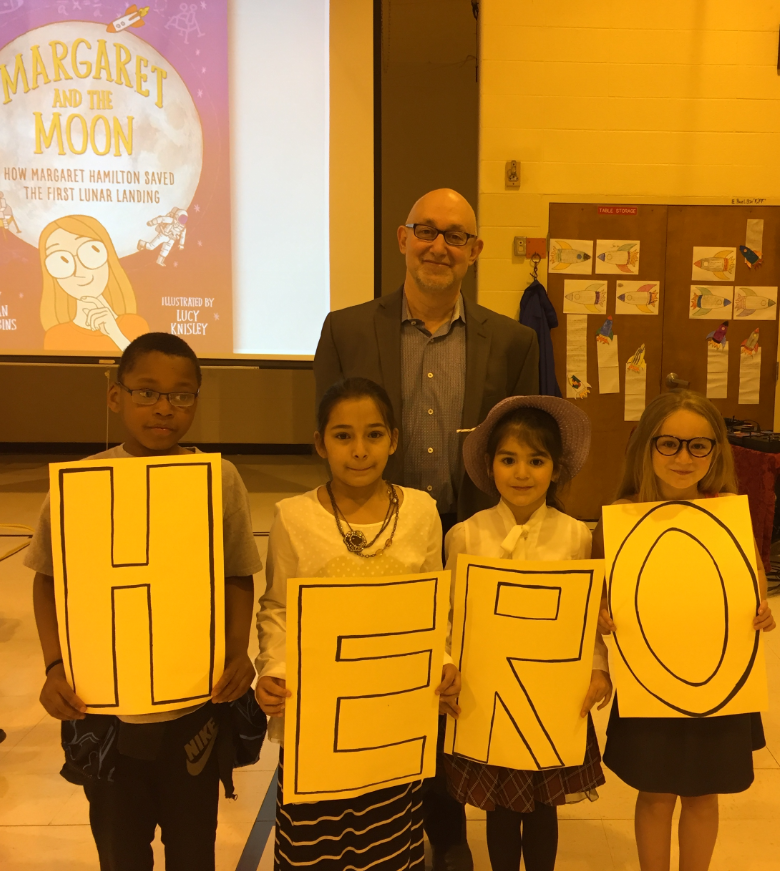 Activities related to real-life heroes
Activities related to real-life heroes
All my nonfiction picture books are about personal heroes of mine: women’s rights activist Susan B. Anthony, abolitionist Frederick Douglass, suffragist Alice Paul, computer scientist Margaret Hamilton, astronaut-artist Alan Bean, scientists Jane Goodall and Jonas Salk, Supreme Court justice Ruth Bader Ginsburg, musician Viola Smith, activist Malala Yousafzai, deaf daredevil Kitty O’Neil, and others. My love of real-life heroes sprang from my love of superheroes as a child. Here are activities to prepare students for my presentations on heroic figures.
- If you were a superhero, what would your special name be?
- If you were a superhero, what would your special powers be?
- If you were a superhero, what problems would you solve to make the world a better place?
- Draw yourself as a superhero in action, using your special powers to make the world a better place.
- List the special powers that can make someone a real-life hero.
- List the qualities that might keep someone from being a real-life hero.
- List the things you could do to be a hero in your own life, your own home or your own school.
- List your favorite superheroes, explaining what you like about them.
- List your favorite real-life heroes, explaining what you like about them.
- Draw one of your real-life heroes as a superhero in action, using special powers to make the world a better place.
 Activities for ‘The Three Secrets of Writing’
Activities for ‘The Three Secrets of Writing’
I’ve had a long career as a writer, from print and broadcast journalism to children’s books. This presentation engages kids in the writing process and reveals the secrets to cultivating their skills. Using multimedia and audience interaction, I explore setting, character, and plot and explain how to incorporate these key elements into a good story. Along the way, I use my nonfiction picture books as examples while relating my journey as a writer. The presentation concludes with a brainstorming activity to start kids on writing great stories of their own.
- Think of your favorite book and describe the author’s main idea in a sentence or two. For example, the main idea of Peter Pan is that the three Darling children meet a boy who never grows up and have adventures with him in a magical place called Neverland.
- Think of your own good idea for a good book and describe it in one or two sentences.
- Think of your favorite book and make a list of everything the author needed to learn about before writing it. For example, the author of Peter Pan, J.M. Barrie, needed to learn about pirates, dogs, crocodiles, and fairies.
- Think of what good information you’d need for your own good book and make a list of everything you would need to learn about before writing it. Make a list of the places where you could find the information, like libraries, books, or a computer.
- Think of your favorite book and write down what happens in the beginning, what happens in the middle, and what happens at the end. Explain how these three parts come together to make a good story. For example, in the beginning of Peter Pan, the three Darling children meet Peter at their house and then fly off with him to Neverland. In the middle, Peter clashes with the pirate Captain Hook, who captures the Darling children. At the end, Peter rescues the children and gets them safely back home.
- There are many ways to tell a good story, but a common way is to have a hero, a villain, and a problem for the hero to solve. Think of a book that tells the story this way and identify the hero, the villain, and the problem. For example, in Peter Pan the hero is Peter, the villain is Captain Hook, and Peter’s problem is rescuing the Darling children from the pirate ship.
- Think of your own good story for a good book and describe the hero, the villain, and the problem the hero has to solve.

